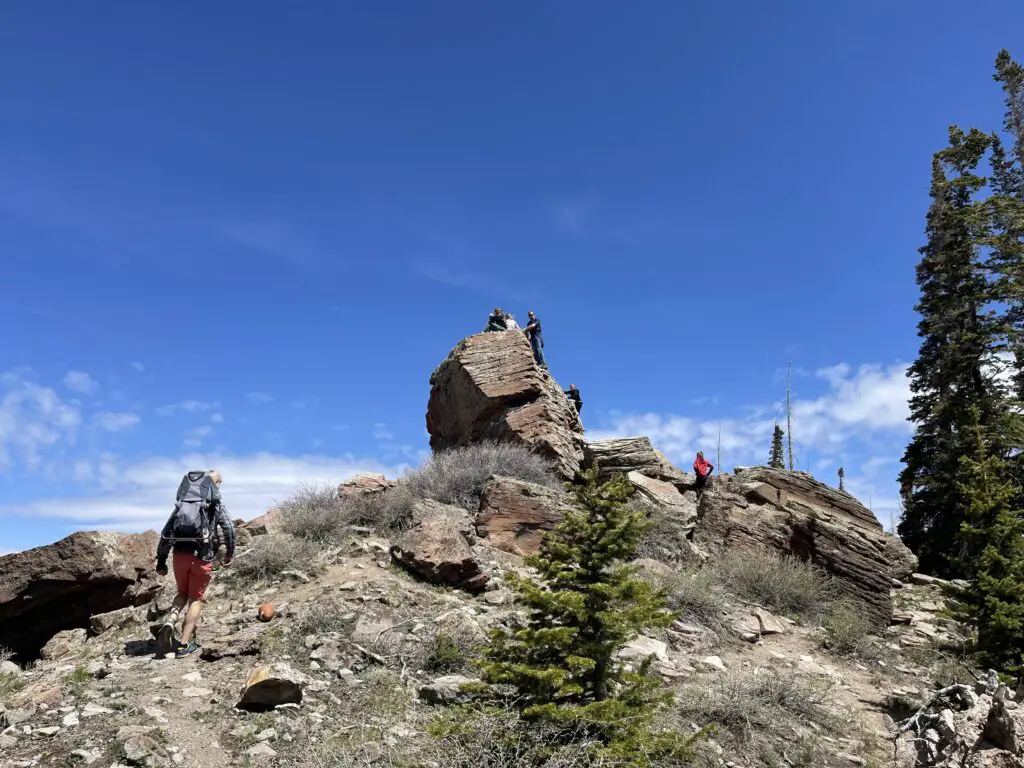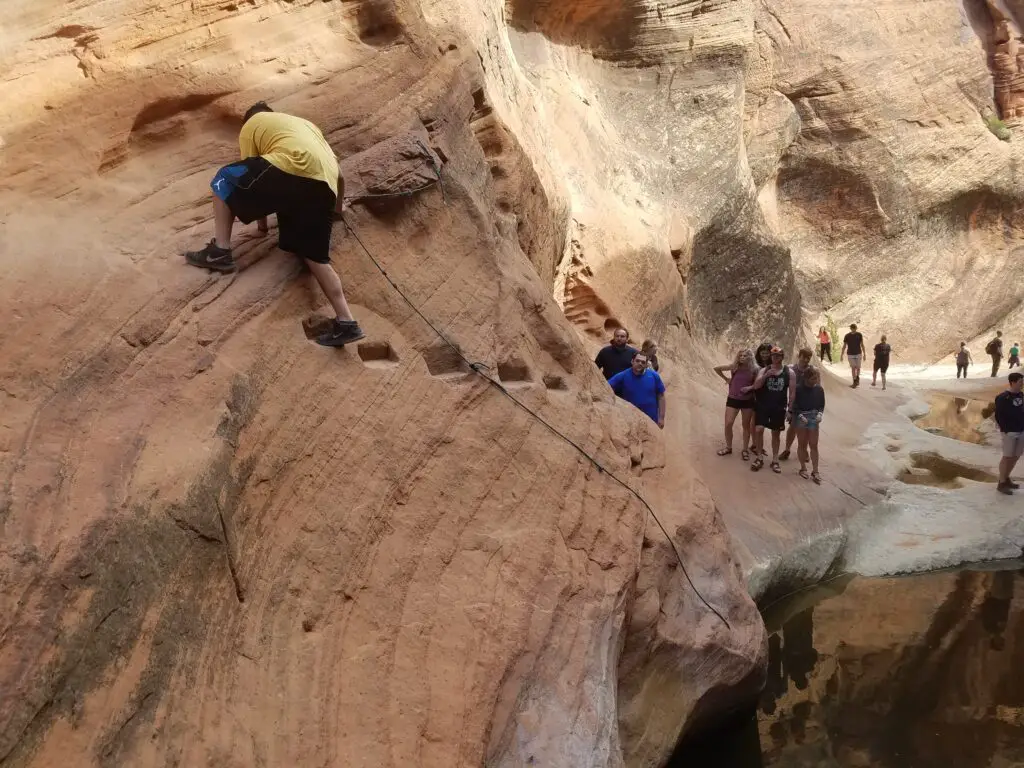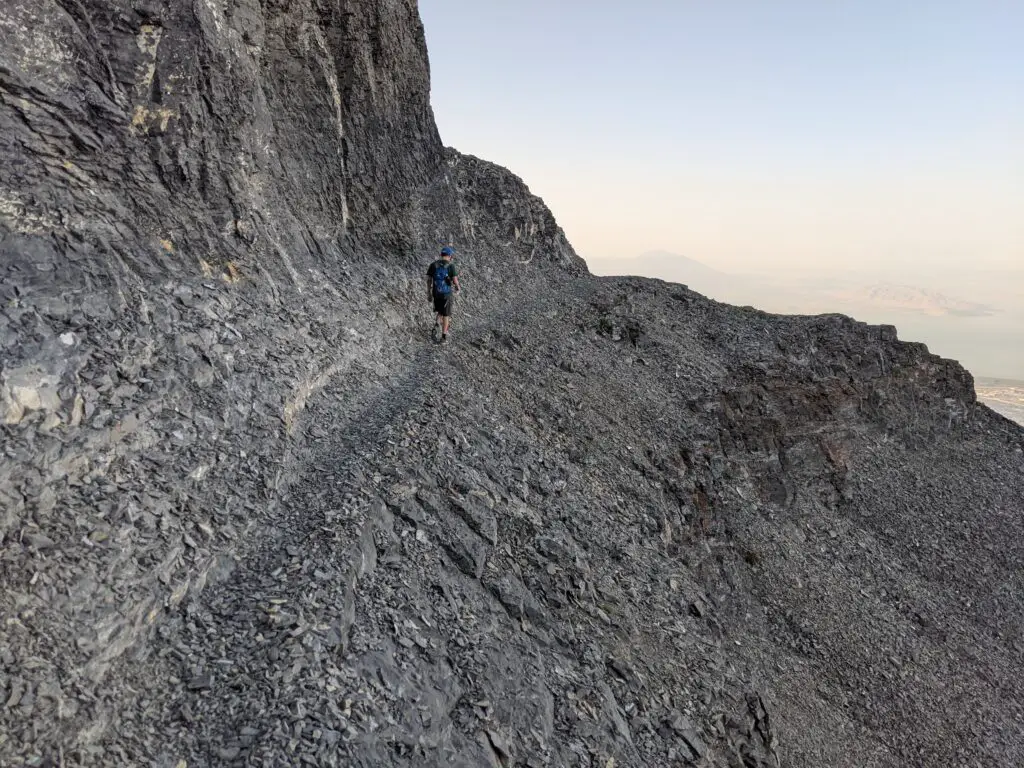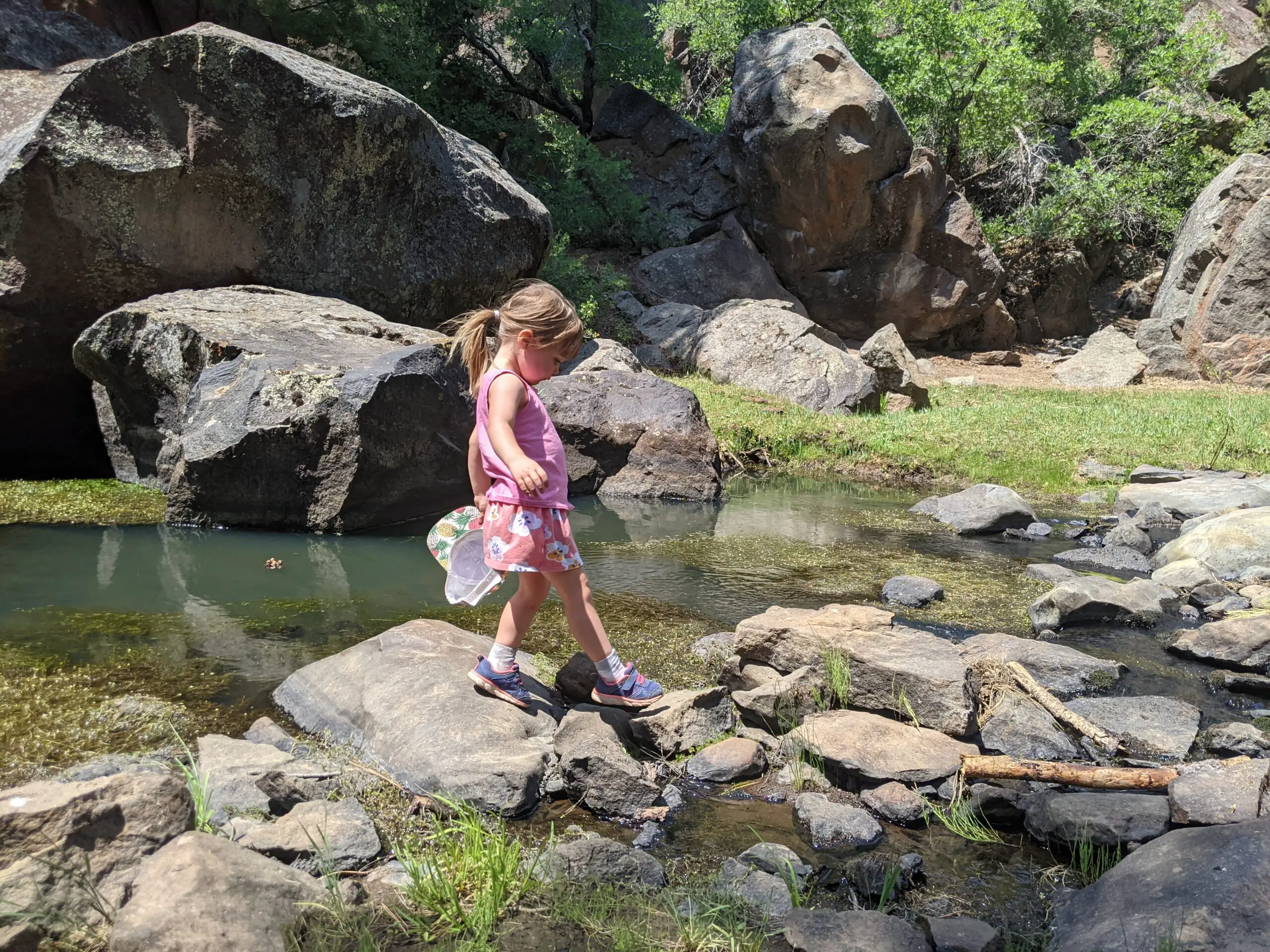I love taking new people outside for adventures they’ve never done before, whether it be rock climbing, canyoneering, mountain biking, hiking, or something. One of the most stressful parts about it though is deciding just how much of an adventure the group can handle. If I overestimate their capacity then it turns into a sufferfest that most people won’t enjoy, but if I underestimate it then they won’t grasp how much fun it is.
The longest distance a beginner hike should be is 5 miles (or 1.5-2 hours) for someone who has an average fitness level. It’s best to select a trail that is out and back rather than a loop in case you run into unforeseen challenges so you can cut it short. For someone in not-as-good shape, a hike of 3 miles is plenty. The elevation gain and difficulty of the terrain also determine how long a beginner hike should be.
The length and difficulty of the hike should be adjusted based on the beginner’s other outdoors experience and overall fitness level, as well as their appetite for adventure. Here are some tips for making sure you don’t end up stranded somewhere in the wilderness!
How Long Can Beginners Hike?
I have taken a lot of groups of beginners on hikes and adventures over the years. Most of them have been groups of teenagers , but there have been plenty of other groups from other demographics as well.
, but there have been plenty of other groups from other demographics as well.
I’ve gotten better over time at evaluating a group’s readiness prior to selecting a hike. Generally, a limit to any of these factors means I’ll drop the length of the hike from 5 miles down to about 3. With several limitations, a hike of 2 miles may be more appropriate. These are some of the factors I consider:
Age of Hikers:
Most of my experience comes from taking teenage boys hiking. They’re generally really high energy, and often do a lot of running and exploring along the trail as we go. Adults tend to do a lot less running around and exploring, but also usually have lower energy levels.
| Age of Hikers | Length of Hike for Beginners |
| Under 12 years old | 1-3 Miles (<5K) |
| 12-18 years old | 3-5 Miles (5-8K) |
| 18-40 years old | 5 Miles (8K) |
| 40-60 years old | 3-5 Miles (5-8K) |
| 60+ years old | 1-3 Miles (<5K) |
Obviously age is just a rough starting point. Things like fitness level can easily override age demographics, but it’s a helpful place to start.
Approximate Fitness Level of Hikers:
Take a look at the group, or take a look in the mirror. Are these occasional 5K runners and gym rats? Or are they more sedentary home-bodies? Again, you don’t want to bite off more than you can chew and get yourself stuck out in the wilderness, but want to give them just enough of a challenge that they enjoy it.
Runners make great hikers, so generally if your group is in decent running shape you can go ahead and plan a 5 mile hike. For non-runners that are relatively fit, it might be best to plan something a little less than 5 miles for a beginning hike.

Hiker’s Experience in the Outdoors:
It’s also important to factor in the novice hiker’s experience and comfort level in the outdoors before just hauling them down an unmarked trail into thick woods. City-dwellers may not be comfortable with a full immersion in nature on their first try.
There’s also something to be said for the technicality of the trail and route-finding difficulties. If the trail is rocky or has lots of exposed roots it can be extra-difficult for people to navigate. If you’re planning a beginner hike yourself, make sure it’s one that is well marked or where you’ll have cell service to track yourself on the trail.
Anticipate slower-going over difficult terrain, especially if there’s route-finding involved. Really thick woods can induce claustrophobia in some people, and exposed trails near cliffs can make people really anxious. It’s best to save those for those more experienced in the outdoors.
Weight of Hiker’s Backpacks:
A heavy backpack can really ruin a hike for a beginner (or even someone really experienced). This is more important for backpacking when you have a lot more stuff to carry, but even a day hike can get heavy.
Heavy backpacks, including baby carriers, make hiking a lot more difficult. They feel like they’re dragging you back the way you came. They can also reduce airflow around your back which can cause you to sweat a lot more.
The rule of thumb for hiking backpacks is that your loaded day pack should weigh no more than 10% of your body weight (for backpacking, it’s 20%). I’ve found these guidelines to be pretty conservative, which is good for beginners.
For a hike that’s under 5 miles in good weather, all you really need is water, some snacks, and minor emergency equipment. That will weigh a lot less than 10% of your body weight. Once you add in extra clothing for winter conditions or extra gear for activities like rock climbing or fishing though, you can hit that mark pretty quickly.
One tip is to use a small backpack that forces you to limit how much you carry. That way the only things you can fit are what you really need for the particular hike. Generally something like an 18L pack is plenty for a day hike.
Hiker’s Home Elevation:
There’s a reason so many Olympians (both from the US and elsewhere) train in the mountainous regions of Utah and Colorado. At higher elevations the air has less oxygen in it so you will find yourself out of breath a lot faster.
In my experience you really start to feel the difference when you go up by about 3000 feet from where you live. If you live at sea level and plan to hike a trail at 10,000 feet or higher, you’re in for a rude awakening. Give yourself a few days to acclimate before taking on a challenging hike at an altitude significantly higher than where you live.
Of course you also need to consider the elevation changes on a hike. One of my favorite moderate hikes in Utah is Lake Blanche, which is just a 3 mile hike. The hike ascends about 3000 feet though over the 3 miles, which ends up feeling like you’re hiking up a really long staircase.

Size of Group:
One often overlooked factor is the size of the group of hikers. A group of 2 hikes a lot faster than a group of 5 or 10. This is because any group of hikers is constrained to the slowest hiker’s speed. Any injury or gear malfunction or other type of slow down affects the entire group.
A hike through more difficult terrain, especially one that includes scrambling, will slow a group down even further as it creates bottlenecks at the most difficult parts. I think a larger group size probably slows down a hike by about 10-20%.
A larger group size doesn’t necessarily limit how far you can hike, but you need to factor in the reduction in speed when evaluating how far you can go.
Weather Window:
Weather can be a major one in some parts of the world and during certain seasons. For example, if you’re hiking in the winter in a snowy region you need to be sure that you give yourself plenty of time to finish before any inclement weather is forecast or before nightfall.
Where I live in the desert, we have to watch out for monsoon storms in the late summer every afternoon and high heat advisories during the hottest months all day. It’s important to recognize which of the aforementioned factors can really slow down a hike and be sure to watch out for weather windows.
6 Common Mistakes Beginner Hikers Make
New Boots
I see this all the time with new hikers. They go to a local outdoor goods store or somewhere like REI and get talked into a brand new pair of clunky hiking boots. Then, rather than wearing them around for a few days to break them in, they wear the new boots for the first time on a hike.
Any shoe, but especially boots, won’t fit perfectly around your foot and can cause ‘hot spots’ that rub continuously and cause blisters. A blister may not be a big deal on a shorter hike, but it can make you miserable on a longer hike, and can become a safety issue on a multi-day trip.
Whatever shoe or boot you decide to wear on a hike, make sure you wear it around town for a few days to start breaking it in. If you notice hot spots developing around your ankle or on one of your toes, wrap the spot with moleskin or a piece of duct tape (good things to have in your hiking first aid kit).
For most people I don’t recommend hiking boots. They do have a time and a place (muddy areas, people with weak ankles, really unstable terrain), but for most people I think approach shoes or trail running shoes are better.
or trail running shoes are better.
These shoes are designed to be lightweight and breathable, and are usually a lot more pliable and comfortable than bulky hiking boots. I’ve noticed a trend in the outdoors over the past 5 years or so where a lot of people are switching over to these types of hiking shoes rather than traditional hiking boots.

Pack Overweight
A heavy pack can really slow you down and cause unnecessary pain and anguish. I’ve been on backpacking trips where we have to stop halfway up a trail and go through a teenager’s pack and we find things like cans of beans.
As was mentioned previously, your pack should weigh no more than 10% of your body weight for a day hike, or 20% for a backpacking trip. One of the best ways to conserve weight is to plan to refill water on the trail if there’s a waters source available. I wrote up this guide with the best methods for filtering water while hiking .
.
Coordinate with your hiking group so that you don’t end up with a lot of unnecessary duplicate gear like water filters, first aid kits, or stoves. This will help conserve weight as well, especially for a larger group.
Pack Underweight
The reason hiker’s packs are often overweight is that they are over-prepared. If you’re going on a 5 mile hike and there’s no rain in the forecast, you probably don’t need a rain jacket. On the other hand, weather systems can develop quickly in the mountains and you should be prepared for any plausible emergency situation.
If you roll or break your ankle a few miles into your hike on a remote trail, can you survive the night before someone comes to rescue you? If you get lost off-trail, do you have some method for contacting searchers? What if the water source you planned on filtering has dried up or is not drinkable?
You don’t need to bring everything you own on a hike, but minimalists get caught unprepared all the time when they plan a hike expecting perfect conditions. Accidents happen, and if they happen in the backcountry you should be able to take care of yourself in most situations.
Fail to Factor in Elevation
A lot of people fly into mountainous areas from out of town and expect to be able to start hiking immediately. It can even affect those who live in higher elevation areas.
I remember one time a few years ago when I went from 6,000 feet elevation up to 10,000 on a trip and thought I could go on a run first thing the next morning. Nope. I didn’t make it very far. Elevation really makes a big difference on oxygen levels.
Give yourself time to acclimate or plan extra time to go slowly for the first few days you’re in a higher elevation area.
Fail to Factor in Elevation Changes
If you just look at a brief description of a hike or look at Google Maps for the route, you may not notice the elevation changes. A 3 mile hike across flat terrain is totally asinine for most people; however, a 3 mile hike with 3000 feet elevation gain can present quite a challenge.Don’t overlook the elevation changes in a hike.
Don’t Tell Anyone
If you read survival stories of lost hikers in the news like I do, the ones who are rescued almost always have one thing in common- they left someone a note with the trail they planned to hike and an estimated return time. When the return window passes, a concerned family member or friend can call in the cavalry to come looking.
For me, that role is usually filled by my dad. I’ll text him the name of a hike or canyon along with the time he should call in search and rescue if he hasn’t heard from me. When I worked in an office I used to leave a sticky note on my computer monitor, instructing my coworkers that they should come find me at whatever place if I wasn’t back on Monday.
You can avoid a ton of potentially dangerous situations by letting someone know where you went and when you’ll be back.

Related Questions:
How Often Should You Stop On A Hike? It is best to take a break of about 5 minutes every hour of hiking, but more frequent stops may be appropriate depending on your fitness level, the weather, and the elevation gain. It’s important to rest as needed throughout a hike so you don’t overexert yourself.
Are Stairs Good Training for Hiking? Climbing Stairs are one of the best methods for training your body for a hike. This can include stair machines at the gym or real stairs in a building. It is especially beneficial if you intend to go on hikes with a lot of elevation changes.
What is a Good Length for a Day Hike? A day hike is usually around 5 miles for beginners, or around 10 miles for more advanced hikers. Hikers can do up to 20 miles in a day over tame terrain with good weather.

